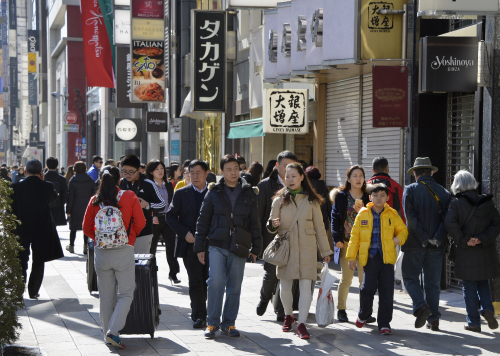|
 |
|
BIG SPENDERS: Chinese travelers walk down a street in the upscale Ginza shopping district in Tokyo on February 19. Outbound tourists from China now possess big purchasing power (CFP) |
Free-ride economics
Xu Xiaolan, Secretary General of the Chinese Institute of Electronics, suggested promoting the development and infrastructure of transnational e-commerce as part of the effort to expand economic connections between China and regional countries.
"By establishing a transnational e-commerce network accompanied by related industrial chain, regional countries can achieve a wider scope of free trade," said Xu. "The development of transnational e-commerce will directly drive the growth of modern service industries such as logistics, electronic payment and electronic authentication."
Peng said economies in the Asia-Pacific have unique advantages pertaining to their own industrial structures, making them highly complementary to each other and thus rich with potential cooperation opportunities. Peng suggested that regional countries should deepen the free trade zone strategy by speeding up the establishment of the Regional Comprehensive Economic Partnership (RCEP)--a proposed free trade agreement first raised by ASEAN nations, aimed at facilitating economic integration in the region.
In addition, Peng said, the Asia-Pacific prosperity concerns not only regional economic expansion, but social development as well. Many people in ASEAN nations have long suffered from preventable infectious diseases such as cholera, plague and avian influenza. China should actively participate in setting up a disease prevention and control system to benefit the poverty-stricken areas in Laos, Viet Nam and Myanmar.
Peng called for the establishment of a China-ASEAN regional public health coordination and cooperation mechanism that would integrate the health sectors of all regional countries.
"We can create a coordination mechanism which could take the form of an annual joint conference between China and ASEAN nations on infectious disease prevention and control. Regular sessions could allow for the sharing of information and experiences in combating health problems," Peng added.
Challenges
Ma Zhiwei, Vice Chairman of the CPPCC Qinghai Provincial Committee, said that the Asia-Pacific prosperity will advance at a varying pace among regional countries due to differences in political systems, culture and values among other unforeseen variables. However, Ma suggested that China promote the comprehensive cooperation of the Asia-Pacific by targeting specific goals for in-depth collaboration in key areas.
Ma noted that the United States has proposed advancing cooperation with Central and South Asian countries through counter-terrorism mechanisms as well as deepening bilateral ties with those countries, in an apparent attempt to contain China and Russia. Russia, meanwhile, is aiming to create a Central Asian Union by integrating the Commonwealth of Independent States through the Eurasian Economic Community and Collective Security Treaty Organization. In addition, both India's Look West Strategy and Iran's claiming of the Caspian Sea as its backyard are seen as responses to China's rising economic status.
But the Belt and Road Initiatives reflect the peaceful nature of China's diplomacy. China can use the initiatives as communication and cooperation channels to further strengthen all-around exchanges with the United States and other Asia-Pacific countries in the fields of politics, economy, culture and military, thereby deepening mutual trust and understanding, Ma said.
At present, the "three forces" of terrorism, extremism and separatism have run rampant in Central Asia, leaving some regional countries in turmoil. The territorial dispute between India and Pakistan has the potential to trigger a military clash at any moment. With the additional outside interference of various political forces, these destabilizing factors pose serious security threats to China and other regional countries. China's Belt and Road Initiatives could thus play a role in eliminating these risks by both promoting regional trade and strengthening exchanges between different nations and cultures--a plan that could eventually enhance regional security and stability by helping to eradicate terrorism, extremism, separatism and other emerging global threats.
Copyedited by Joseph Halvorson
Comments to lanxinzhen@bjreview.com | 